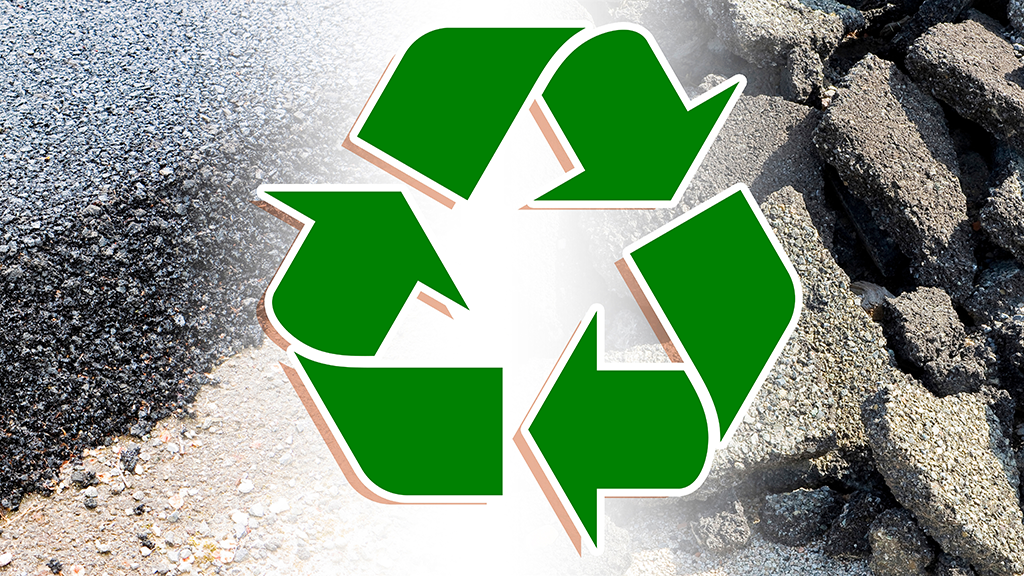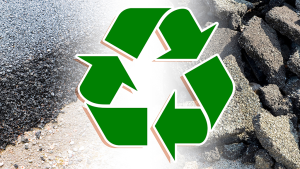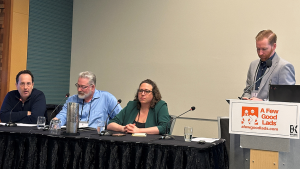In one of the numerous seminars at the recent Good Roads conference in Toronto, a three-member panel of asphalt technical specialists turned the spotlight on sustainability and environmental initiatives in the roadbuilding sector.
A keynote message delivered by one of those speakers, Good Roads’ senior specialist of technical programs and research Amin Mneina, is that municipal use of Recycled Asphalt Pavement (RAP) is on a major upswing.
Of an anticipated 2.05 million tonnes of asphalt to be installed this year, approximately 194,000 tonnes of RAP will be used in road construction and maintenance projects.

“That is a 70 per cent increase from 2024,” he told the almost filled-to-capacity audience.
Those estimated figures are based on responses to Good Roads’ annual Municipal Paving Forecast. There are 444 municipalities in Ontario, of which 77 responded. That is still a good sampling because those 77 municipalities comprise 83 per cent the province’s population, he said.
Use of RAP is steadily increasing and during the past five years 15 municipalities have changed their specifications allowing it. A growing number of municipalities are also piloting or considering new products or technologies such as fibre reinforced asphalt, said Mneina.
The amount of predicted RAP use this year will generate significant environmental and cost benefits compared to simply relying on new material, the audience was told.
Those benefits include an approximately three-million-kilogram reduction in CO2 emissions, 446 thousand cubic metres of savings in freshwater consumption, and an approximately $16.5 million savings for asphalt cement and aggregates, he said.
Focusing on other issues, Mneina also briefly touched on the work of the Ontario Asphalt Pavement Council (OAPC)/Good Roads Municipal Hot Mix Asphalt Liaison Committee. Its mandate includes facilitating the development of a best practices guide, educational materials and recommending asphalt-related updates to OPSS specifications.
Attendees also heard about the many programs and commitments of the Ontario Road Builders’ Association (ORBA) and the OAPC, which is a council of ORBA, to meet the 2030/2050 net-zero targets.

“We are reevaluating our plans and procedures with everyone on board,” said ORBA/OAPC’s outgoing technical director Doubra Ambaiowei.
A major step in reducing the roadbuilding industry’s environmental impact in Ontario is the development of environmental product declarations (EPDs) which would list the processes and materials used in the creation of asphalt mixes.
“EPDs give a complete impartial third-party verified report on the environmental impacts on the specific product produced at a particular plant. They are the gold standard for reporting environmental impacts without revealing operational details.”
ORBA/OAPC is working with the National Research Council Canada and the National Asphalt Pavement Association (NAPA) in the United States to implement the system in Ontario. NAPA is the creator of the Emerald Eco-Label software tool and the goal is to update it so it would be applicable in Ontario and across Canada, said Ambaiowei.
Additional efforts to decarbonize include the publication of OAPC’s updated Environment Practices Guide in March 2024. Its purpose is to assist asphalt plant operators in operating and maintaining their facilities “in a manner that minimizes potential environmental impact.”
The EPC guide is a critical component of OAPC’s self-regulated Trillium Award Program, which is in the midst of a long-term transition to third-party certification. This would assure owners of the plants’ commitment of supplying hot mix asphalt of the specified quality. But they’re several steps involved before certification can be implemented, said Ambaiowei.
First implemented in 2002, the Trillium awards recognize excellence in hot mix asphalt plant operations. The very rigorous criteria include the plant’s appearance, safety, environmental initiatives and community relations programs, he said.

The third speaker was Sina Varamini, chair of the Ontario Asphalt Expert Task Group. This is an independent body comprised of a mix of asphalt industry representatives, owners and academia, with a mandate to advocate for improved asphalt pavement performance.
It has conducted more than four years of industry-led, independently verified research through the Ontario Mix Asphalt Program (O-MAP) and has issued a call to action for municipalities across the province to harmonize their use of performance-based asphalt testing in both specifications and contractual agreements, he said.
“This work has produced a ready-to-implement framework that helps municipalities and agency owners enhance the consistency, durability and sustainability of asphalt pavements across the province.”
A key benefit of this framework is that it helps municipalities and other industry players better assess the impact of RAP and other conventional or modern recycled materials on pavement performance, said Varamini.







Recent Comments
comments for this post are closed